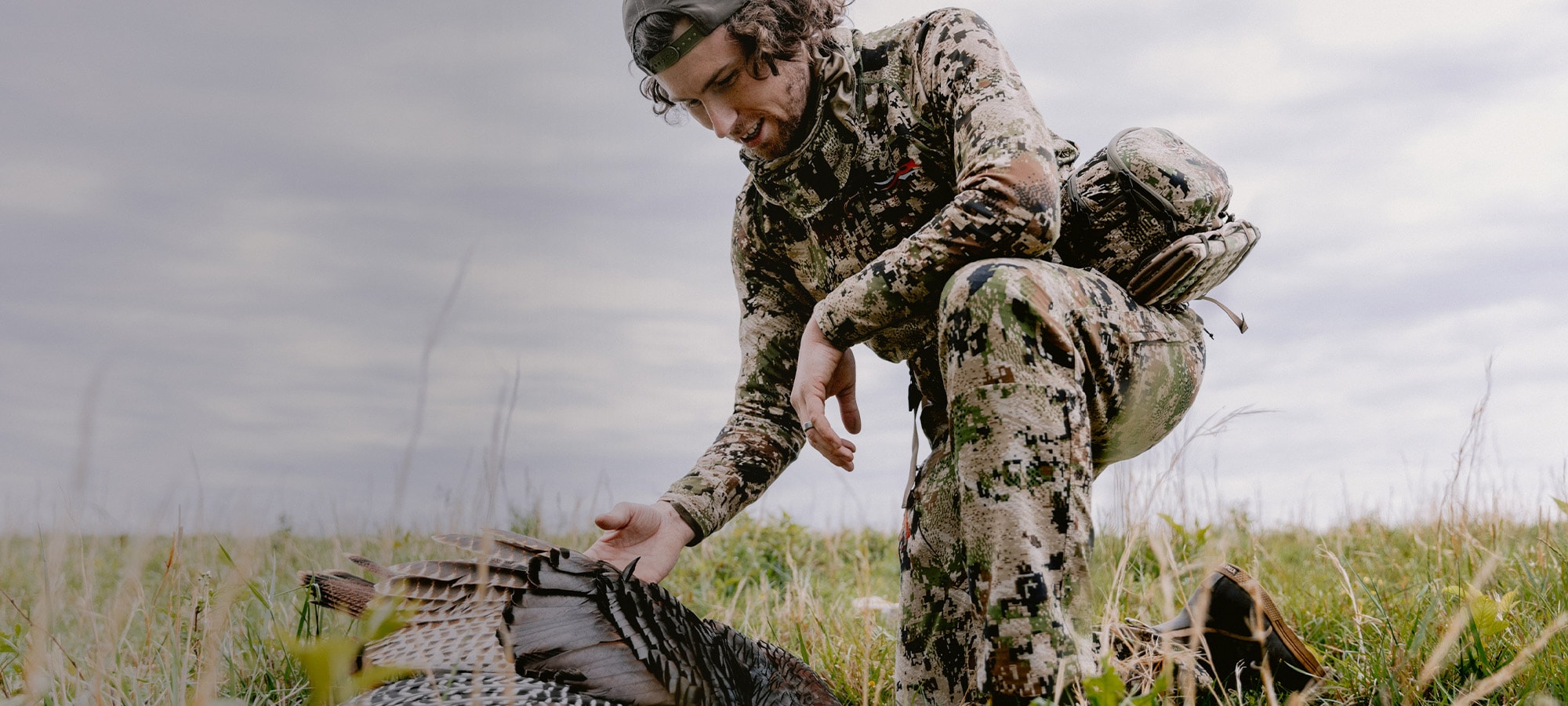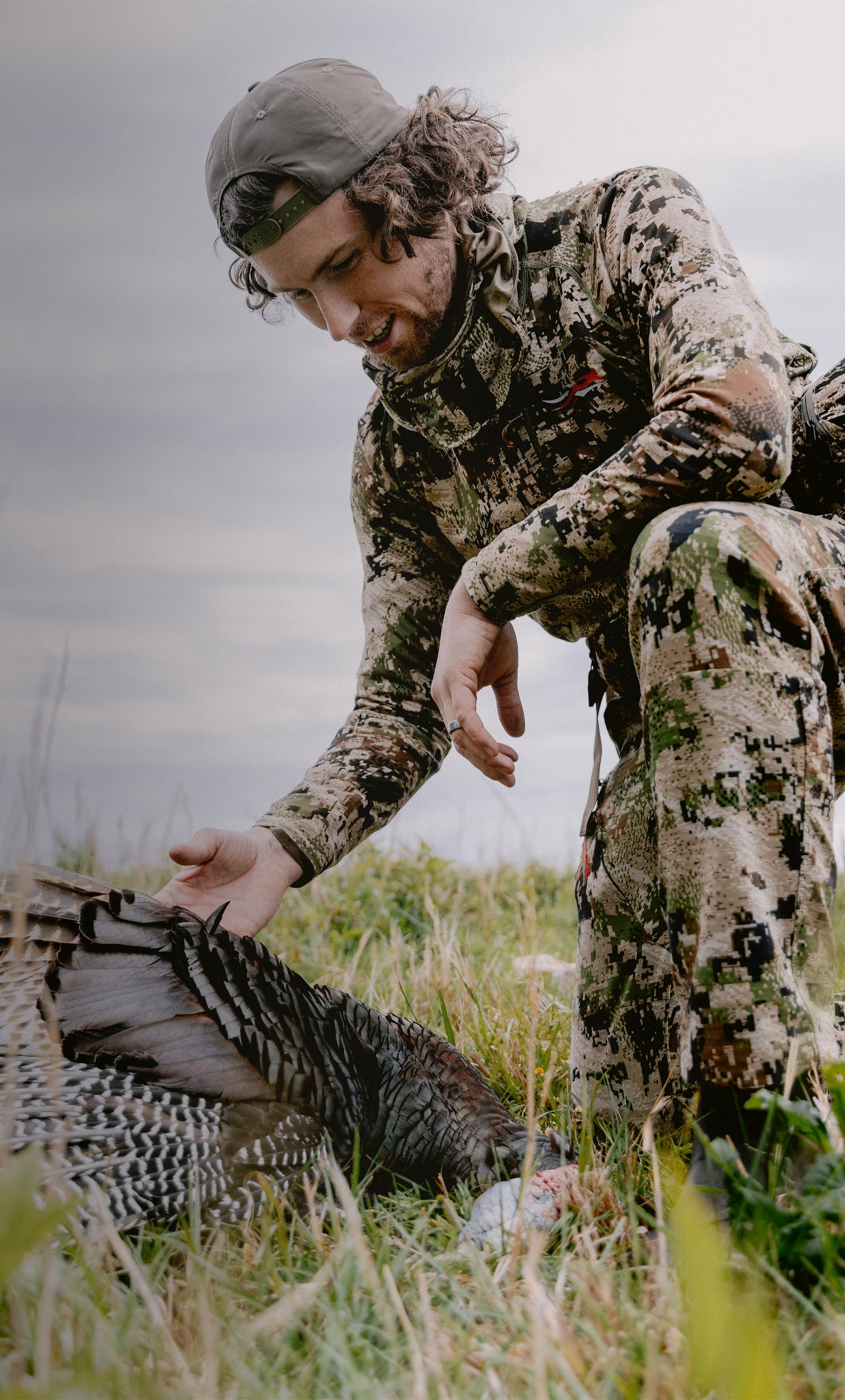There’s no feeling quite like hearing a wild turkey respond to your call, whether you’re hunting public land or the back 40. To help you find success on opening day and beyond, we’ve put together this list of turkey hunting tips to help you find toms, call them in, and bring them down. Any successful turkey hunt starts with a bit of planning and strategizing, and ends with a good dose of adrenaline followed by delicious wild turkey on the dinner plate. Utilize these turkey hunting strategies to help you find success in the turkey woods.
Mastering Turkey Calls
Variety in Calling
A common mistake of the turkey hunter is to simply not carry enough calls. Finding wild turkeys and calling them in often requires trial and error. Having a diaphragm call or two, a box call, and a friction turkey call with a variety of strikers will allow you the flexibility to mimic natural turkey sounds no matter the situation. Practice a variety of yelps, clucks, and purrs beforehand so you’ll have plenty of confidence when you’re out hunting, and learn more turkey calling tips in our blog.
Volume and Approach
Start calling quietly and only gradually increase your volume. Mix it up between purrs, whines, yelps, and clucks. Stop and listen. Wait a while before trying again. Don’t be afraid to mix it up and try different calls and techniques. Male turkeys are often stubborn and won’t come until they hear just the right call. If there’s only one turkey hunting tip you follow, master your calling technique with plenty of practice. Watch videos of turkeys making their natural noises, and try to mimic those noises with your own turkey calls at home before the season.

Tactical Approaches
Decoding Turkey Behavior
Hunter education is critical if you want to hunt turkeys successfully. To know where the gobblers will be come spring, get out and pay attention well before turkey season starts. Wherever the hens are, the toms will not be far behind. Turkeys are birds of habit, so if they’re frequenting an area before the season, they’ll likely continue making their way to that spot opening morning. Time of day is also an important consideration, as they’ll often follow similar patterns day to day. For example, wild turkeys will often come out of their roost tree each morning to a food source, such as a corn field, so knowing where this spot is can be crucial to knowing where to position yourself before dawn.
Positioning and Movement
Whether you’re hunting Rio Grande turkeys in Texas or Merriam’s in South Dakota, knowing where to be and when is key to a successful turkey hunt. Wherever you plan to start out the day, get there early. This will often be near a known roost tree. Just as in whitetail hunting, it’s best to be at your spot, still and silent, a good half an hour before shooting light to allow the woods plenty of time to settle after your stealthy walk in. If you’re run-and-gun hunting and not at a known roost tree, walk a path or road, stopping every 50 or 100 yards or so to call and listen. When you do hear a response, don’t immediately set up, but instead observe the landscape and topography around you. Try to position yourself with a crossable path between you and the turkey. A tom will likely be unwilling or unable to cross an obstacle, such as a fence or thick brush, to come in toward you. When you’re on the move, be sure to carry a hunting backpack or vest like the Equinox Turkey Vest to allow you to move fast and light while keeping your calls and gear at the ready.

Utilizing the Terrain
Strategic Setup
Much like the tip from the previous paragraph, this one involves paying attention to your surroundings—and not just during the season. This all comes down to pre-season observation and scouting, whether you’re running trail cameras or just getting out and glassing frequently. You should know the territory you’re hunting like the back of your hand. Know all the travel corridors turkeys use. Know their food sources and where they stop to eat. Know the open fields where male turkeys strut. And know the topography and obstacles that will dictate their patterns and funnel them into certain spots where you’ll be able to position yourself. This kind of observation can only be done by boots-on-the-ground pre-season scouting. These things can change year to year due to factors like weather and flooding, recently downed trees, planted fields, and new growth.
Using Natural Cover
When hunting turkeys run-and-gun style, you won’t have the advantage of a ground blind, so a successful turkey hunter will need to be able to quickly find natural cover when trying to call in a bird. Wild turkeys are spooked by the slightest movements, so a great wild turkey hunting tip is to back yourself up to natural cover to prevent your silhouette from being visible. This cover could be natural resources like downed trees or brush, the trunk of a large tree, a wall of rock, or something similar.

Gear and Equipment
Choosing the Right Camo
Whether you’re spring turkey hunting or chasing birds late season, it’s important to select the right concealment pattern for your particular area. GORE™ OPTIFADE™ Concealment patterns have been designed by experts in both camouflage and animal vision. OPTIFADE™ Subalpine and OPTIFADE™ Elevated II are two patterns popular amongst turkey hunters. Subalpine is excellent for tree-covered and vegetated terrain. Elevated II is excellent in dense foliage and is perfect for fall turkey hunting once the leaves have changed.
Whether you’re spring turkey hunting or chasing birds later in the season, it’s important to select the right concealment pattern for your particular area. GORE™ OPTIFADE™ Concealment patterns have been designed by experts in both camouflage and animal vision. OPTIFADE™ Subalpine and OPTIFADE™ Timber are two patterns popular amongst turkey hunters. Subalpine is excellent for tree-covered and vegetated terrain. Timber is great for darker environments and dense foliage and is perfect for heavily forested areas and for fall turkey hunting once the leaves have changed.
Essential Gear Checklist
When packing for your turkey hunt, make sure you have every piece of turkey hunting gear you need to set yourself up for success:
A hunting vest or pack such as the SITKA Equinox Turkey Vest or Turkey Tool Belt containing the following:
- Diaphragm turkey call
- Box call
- Friction call
- Strikers
- Maintenance supplies for your calls, like box call chalk
- Snacks
- Tags and licenses
- Flashlight and extra batteries
- Knife
- Binoculars
- Turkey Decoys
- Wind indicator
- Rangefinder
- Water bottle
- GPS or cell phone with onX
- Extra ammo (Or broadheads if you’re bowhunting turkeys)
Your weapon with sling and ammo
Your clothing system should include
- Quality synthetic or Merino hunting base layers
- A rugged but lightweight hunting pant like the SITKA Equinox Guard Pant
- Hunting gloves
- Insulating mid-layer like the Ambient 100 Hooded Jacket
- WINDSTOPPER® by GORE Labs jacket
- Waterproof layer like GORE-TEX hunting rain gear
- Lightweight synthetic socks
- Quality, comfortable boots

Advanced Hunting Strategies
Dealing with Pressured Birds
The amount of pressure turkeys face from hunters and predators can really depend on where you hunt, whether on public land or private, and whether you have vast tracts of land available to you or you’re hunting smaller parcels. If you’re hunting public land, you’ll likely find more success hunting times when other hunters aren’t around—try to hunt weekdays versus weekends, and don’t be afraid to go out in less than ideal weather conditions when other hunters might opt to stay inside.
If you’re not hearing turkeys in a spot you know them to be, sit tight for a while and call less frequently. The birds might be there but spooked by your presence. Sit still and quiet for 20 minutes or so before calling again. As with most other species, the further you can get from the road, the more wild turkeys you might find. If lots of space is available to you to hunt, don’t be afraid to put in the miles.
Adapting to Weather Conditions
If you hunt all spring and also get into the fall turkey hunting season, it’s important to keep in mind these tips for wild turkey hunting in different weather conditions, as you’ll likely come across all types of weather at some point. The first and most important tip is to be prepared for any weather. During the shoulder seasons of spring and fall, weather can often turn on a time, and you’ll up your chances of success if you have the right layer to throw on, rather than having to hike back to the truck.
It’s also important to know how different types of weather will affect turkey behavior. Both rain and heat can slow down turkey movement, but neither will stop turkeys from moving completely. A rainy morning may lead to birds staying in their roost tree longer, so the hunting may not turn on until mid-morning. The same goes with sleet or snow. A hot day may lead turkeys to do most of their moving around in the cooler times closer to dawn and dusk. Wind may prohibit turkey movement a bit, but you can also use it to your advantage. Wind will often lead gobblers to protected areas such as thicker timber, so those can be great spots to target. Though turkeys are often more easily spooked on windy days, you can also use the sound of wind to muffle your own sound as you approach.
Prepare for Success with SITKA Gear
We hope this quick overview of some important turkey hunting tips helps you as you prepare for your hunt, but also know that there is nothing that can teach you more than getting out there and putting in time in the turkey woods. To make the most of that time, it’s best to come prepared with a strategy, with plenty of time spent scouting your turkey hunting locations pre-season, and lots of time practicing your turkey calling techniques at home.
Having the right turkey hunting gear and clothing can help you focus on the hunt by eliminating the distraction of discomfort. Success is often a by-product of focus. SITKA’s collection of turkey hunting gear and apparel can help you stay focused in any weather condition for the entirety of turkey season.

